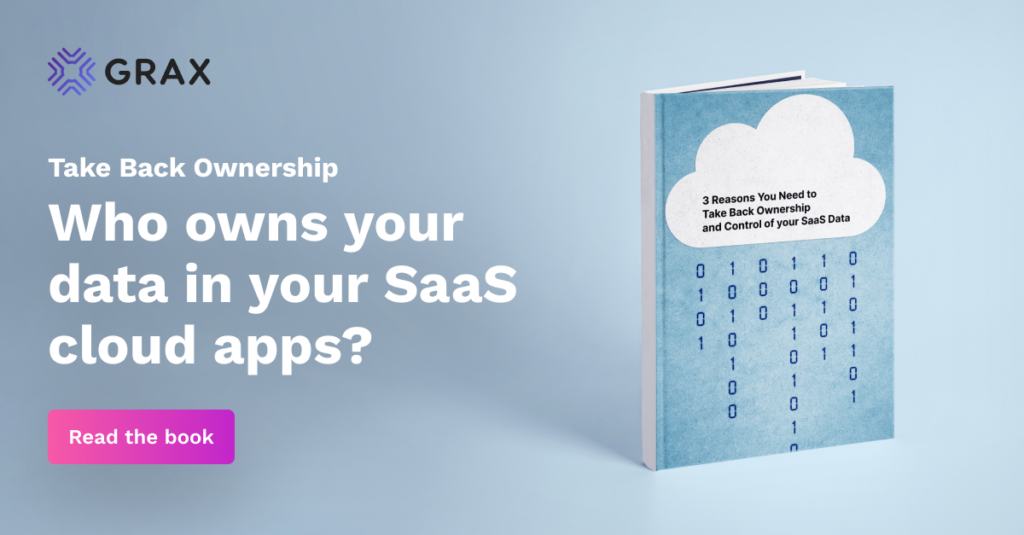
Data has long since become the most valuable resource of any business. Being able to have complete control over the information in question while establishing a multi-layered protection system is a necessity in a modern business environment.
The value of this topic grows even more in industries that are regulated by one or several compliance frameworks, setting strict requirements and frightening consequences for not meeting them. Additionally, a lot of modern businesses rely more and more on cloud-based CRM platforms (Salesforce, etc.), raising a legitimate question of whether there is a risk of relying on the same vendor for primary storage and backup operations and other security measures at the same time.
A Single-Vendor Risk
In the context of data management tasks, Single-Vendor Risk is the collection of limitations and vulnerabilities that are caused by the over reliance of the company on the same provider’s capabilities for both primary storage and backup features. Highly integrated platforms such as Salesforce are the most notable examples of this risk, considering how the overarching ease of use can accidentally lead to an over reliance on its ecosystem.
While most organizations would undoubtedly claim that their customers are going to leave them if their services are not going to offer sufficient levels of security, the existing reality paints a slightly different picture, with many businesses using CRM systems as their primary storage for all kinds of data, including many forms of sensitive information.
The fact that Salesforce is the undisputed leader in this market does not help matters, either, putting even more pressure on the topic of data security for CRM users. The most noteworthy issues that a Single-Vendor Risk might spawn include the increased possibility of data loss, higher potential for extended business downtime, lower levels of protection against data breaches, and even a competitive disadvantage that comes with the lack of data flexibility.
Data independence as a concept is the primary goal of companies that try to avoid vendor lock-in as much as possible. True data independence implies the ability to have complete control over your information without vendor lock-in, including separate storage environments for primary and backup data, separate login data for backup environments, and a separate vendor for backup data management.
Data independence offers many advantages, including enhanced business continuity, lower risks of data loss, and a better feature set for specific backup and recovery goals of each specific company.
Our goal in this text is to uncover various challenges that regulated industries face when managing sensitive information in Salesforce environments. Not only do we aim to help businesses understand the overall regulatory landscape and what it means for the landscape of data backups, but we also try to offer practical steps to achieve true data independence in different environments.
We can explore various best practices for backup and recovery processes, specific industries’ requirements, and compliance frameworks, as well as provide guidance on how to approach the topic of data independence with due diligence to meet all of the compliance and business needs. The independence of data backups is critical in many industries, and achieving it should be one of the primary goals for many organizations for the sake of risk mitigation and compliance.
Part I — A Detailed Look into a Single Vendor Risk
As mentioned before, Single Vendor Risk in data management is the collection of potential shortcomings and vulnerabilities that appear when focusing on a single vendor for both primary storage and backup capabilities. It is a somewhat common issue in modern data-driven environments where the reliance on CRM platforms such as Salesforce is at an all-time high.
Future-Proof Your Business with Salesforce Data Independence
Prevent single vendor risk with GRAX.
Many companies are either not capable of affording or not willing to spend a substantial amount of resources on data security when there are built-in options available. Yet, there are many disadvantages that the single-vendor approach contains, including:
- Regulatory compliance issues are due to many issues that single-vendor backups would have to go through to provide a demonstrable separation of primary and backup data, among other issues.
- Both flexibility and granularity of recovery processes are often a lot higher in third-party solutions than in the backup measures of a primary vendor, limiting the company’s capabilities for complex recovery scenarios.
- The lack of control over backups caused by the existing limitations of vendor-specific capabilities can also be a significant factor. For example, a service disruption in single-vendor environments would remove the user’s access to both primary and backup data.
- Market flexibility also becomes a lot more challenging with single vendor environments since most negotiations and provider changes are much more difficult to perform than in the case of data independence.
System outages are not the only examples of vulnerabilities that single-vendor environments might encounter. Other noteworthy situations include unexpected vendor policy changes that may not align with a company’s business needs, as well as the possibility of both primary and backup data being compromised after a data breach in a single vendor environment.
Of course, there are also a number of issues and risks that Salesforce users encounter when relying on the CRM platform for both primary and backup storage tasks:
- Limited recovery options and the lack of extensive customization are both telltale signs of limited flexibility that are present in Salesforce’s native backup capabilities.
- Significant data loss in such an environment might also result in a much longer downtime than expected, dramatically increasing the total damage of a data breach on a specific company.
- The existing Salesforce backup solution does not have the option of separate storage for backup data, choosing to store it in the same Salesforce environment instead; it is a massive security issue that makes backups vulnerable to outages and other potential issues with the platform itself.
- The same data separation issue mentioned above is problematic from a compliance standpoint, considering how many industries and regulations have a physical separation between primary data and backup information.
A complete understanding of all the risks that the usage of single-vendor environments can bring is crucial for being able to mitigate or resolve them in the future. The goal of the following sections is to explore potential risk mitigation measures to meet all of the modern security requirements.
Part II — Data Independence and Compliance Frameworks
The sheer number and variety of regulatory frameworks and compliance rulesets in a modern business environment have made it possible for a lot of the existing data management strategies to include at least some of these requirements from the start. Most of the regulatory frameworks focus on data resilience, privacy, and security — all of which are standard business practices in a modern environment filled with vulnerabilities and other methods of creating data breaches.
Data independence as a concept is also a common factor in many compliance frameworks, often used as a helpful measure for both business continuity and data protection. Independence from the primary storage provider is supposed to ensure the confidentiality, integrity, and availability of sensitive information that would not be dependent on the primary environment’s uptime.
A list of the most noteworthy global compliance frameworks with backup independence as a requirement is going to be presented below.
General Data Protection Regulation

GDPR is a sophisticated data protection framework that covers all organizations that process EU residents’ personal information in any way. Independent backups are not explicitly mentioned in GDPR, but there are multiple articles and rules that necessitate the inclusion of such practice, such as:
- Article 20 of GDPR mandates the individuals’ right to acquire their personal information in a machine-readable and commonly used format. Backup independence ensures that this could happen even if the primary platform is somehow compromised or not available otherwise.
- Article 25 of GDPR facilitates the usage of a proactive approach to data protection measures, supporting the idea of independent backups and other security measures that can rarely (if ever) be achieved with built-in vendor capabilities.
- Article 32 of GDPR enforces the usage of appropriate organizational and technical measures that ensure the necessary security level to overcome specific risks. One of the primary measures in this article is the ability to restore information in a timely fashion in case of an incident of a technical or physical nature.
Robust backup and recovery measures that can operate independently of the primary storage are an important cornerstone of GDPR compliance.
Health Insurance Portability and Accountability Act

HIPAA mandates, among other things, the necessity to include appropriate security measures to safeguard anything considered electronic protected health information, or ePHI. The confidentiality, integrity, and availability of such information have to be maintained in order to remain HIPAA-compliant.
As for backup independence, HIPAA’s most prominent requirement is the Contingency Plan. It is the implementation of various procedures and capabilities into the system to safeguard the information from an emergency of sorts that has the potential to damage storage environments containing ePHI. Not only does this Security Rule include a data backup plan, but there is also a requirement to have a disaster recovery plan and a plan for emergency mode operations, all of which are mandatory.
It is important to understand that backup independence should be primarily treated as a strategic move for the environment in question, considering how multiple requirements suggest independent backup storage environments instead of demanding them.
Payment Card Industry Data Security Standard

PCI DSS affects all organizations that handle information from credit cards. Similar to other examples, there are no explicit mentions of independent backups, but some of the requirements effectively enforce it without mentioning the name:
- Requirement 10 facilitates monitoring and tracking for all access attempts to cardholder data and network resources.
- Requirement 12.10 enforces the creation of a detailed incident response plan.
Since single-vendor environments cannot offer comprehensive control over the entire environment to enforce such requirements, the usage of independent data backups remains the best option to maintain compliance with PCI DSS.
Financial Industry Regulatory Authority

Unlike most of the regulations mentioned here, FINRA does have a number of specific requirements that a lot of the organizations in the financial industry have to comply with. The usage of cloud-centric CRM platforms such as Salesforce does not free the companies from being subject to such regulations, either, including:
- Records in electronic storage media can only be preserved in a non-erasable and non-rewritable format. FINRA Rule 4511 requires electronic records to be stored in a non-erasable and non-rewritable format, which is also known as WORM (write once, read many). That way, the integrity of the target records is completely secure from both accidental and malicious modification or deletion.
- Easy access to preserved records or books should be established and maintained for at least six years. However, the “six-year” requirement is only true for select data types, such as account records and transaction data. Many other records, such as communications or certain trade blotters, only have to be maintained for three years.
Data preservation and accessibility both benefit massively from the concept of data independence, and most single vendor environments can facilitate neither of these requirements to a degree outlined in the regulation.
Sarbanes-Oxley Act

SOX might not mention data backups outright, but it does demand that the integrity of financial records be kept intact, which facilitates a flexible and independent backup environment. The most important elements of SOX, in our case, are the requirements for:
- Quickly recovering financial records when necessary.
- Protecting financial information against data loss or tampering.
Backup independence can serve as an additional security layer for sensitive information such as financial records, and it is also a best practice for meeting both of the requirements mentioned above.
North American Electric Reliability Collaboration Critical Infrastructure Protection and Federal Information Security Management Act

Both NERC-CIP and FISMA are government-centric regulations that demand a high degree of data protection for national security, among other factors. These regulations are used to maintain the security and flexibility of sensitive information for critical infrastructure and government organizations by following requirements, such as:
- Data recoverability in the event of a data breach or some sort of disaster.
- Safeguarding sensitive information to prevent it from being tampered with or accessed without proper permissions.
- Data backups on a regular basis for improved redundancy and security.
Despite the overall importance of security and availability for all these regulations, backup independence remains a suggestion instead of a requirement in most cases. However, the sheer number of advantages third-party backups can offer is just another example of why backup independence might be a great strategic move for many companies.
As a result, we can see how regulations tend to differ dramatically from each other in terms of requirements and recommendations. However, most of these requirements about data availability, integrity, and security are difficult to ensure in a comprehensive manner without implementing a third-party backup solution.
Compliance in the context of Salesforce and other CRM environments boils down to ensuring that backup strategies are aligned with all the necessary regulations in order to offer a specific level of security without becoming non-compliant.
Part III — Recommendations and Best Practices for Backup Independence
The previous segments should serve as proof of how backup independence is a crucial element for not only data security but also business continuity and even regulatory compliance. This is where we can start going over the recommendations on how to incorporate backup independence into the overarching data protection plan.

Our first step here would be to clarify the differences between primary vendor backups and independent backups. For that purpose, we can point out at least three defining factors:
- Vendor separation is the most obvious factor of the three, implying that primary storage and backup storage should be associated with different vendors. That way, the end-user has more negotiating power, more options in terms of features and solutions, and other advantages.
- Access separation provides an additional degree of security by allowing the storage of backed-up data under a separate login-password combination. The differences in access information can be the defining factor in a modern technological environment where most people are aware of how valuable backups can be in the face of impersonators and ransomware.
- Storage separation is another safeguard against a certain range of issues, but this one mostly revolves around accidental issues rather than intentional ones. The usage of a backup storage environment that is physically separated from the primary data would allow it to survive even if there is a natural disaster or a power outage in the area, improving business continuity.
It should be noted that replication as a feature, while useful in certain situations, is not an alternative to independent backups due to its close connection to the primary data. A single outage for the primary Salesforce environment would be all it takes for the replicated backups to be erased, as well.
The fact that third-party backup providers are practically the only way to achieve data independence, it is important to conduct a thorough evaluation of potential solutions using a number of important criteria listed below.
- Vendor independence is a valuable advantage that is necessary to avoid the potential issues of primary storage that could affect the backup environment.
- Infrastructure separation is another factor towards independence that can be provided by using a separate cloud storage provider or even providing on-premises deployment as an alternative.
- Information mobility is a simple yet important factor that covers the ability to export information in a usable format with ease to prevent vendor lock-in.
- Retention policy flexibility should not be limited by the primary vendor’s capabilities and should be able to meet all of your company’s requirements from start to finish.
- Independent access is important for the reasons mentioned above — acting as another safeguard against impersonation or cyber crimes.
- Compliance assistance is an important element of a third-party backup solution since compliance is something that all companies have to deal with as soon as possible.
On the topic of third-party backup solutions, we should also mention major features that help with achieving data independence so that potential clients can look for these features in their future backup solutions.
- Hybrid Cloud. A certain degree of data independence can also be achieved by using a hybrid cloud approach that allows backups to be placed both in on-premises and in cloud storage depending on the sensitivity of information or some other factor.
- High Level of Integration: Backup solutions with the ability to utilize the data exporting API of Salesforce (or some other SaaS environment) can generally offer a higher degree of customization and flexibility for their backups.
- Data Archiving: Backups can also be used alongside other useful features, such as archiving — an option that can improve data management capabilities while reducing storage costs without losing long-term access to historical data.
- BYOC: The Bring Your Own Cloud approach makes it possible to use your own cloud (or on-premises) storage for backup safekeeping instead of relying on what the backup solution has to offer, improving versatility.
- Multi-Cloud Approach: The risk of losing access to data backups in a backup solution can be reduced by using multiple cloud environments for storage purposes (if the solution supports it).
It should be noted that these features are not strictly mandatory but highly recommended in many situations. They can be used to look for software that can assist with reaching true backup independence — simplifying compliance while also improving information security in multiple ways, regardless of the state of the primary SaaS vendor, such as Salesforce.
Part IV — Data Backup Requirements in Specific Industries
Backup independence can offer many advantages in any industry, but there are some sectors and environments where its usage is practically mandatory. In one of the sections above, we went over several examples of compliance regulations that are involved with backup independence to a certain degree, but we are going to use the same examples to showcase the situation in specific industries.
Critical Infrastructure and Government Agencies

North American Electric Reliability Collaboration Critical Infrastructure Protection and the Federal Information Security Management Act are two examples of regulations that affect companies in the fields of critical infrastructure and government contracts. Both requirements have a high expectancy in terms of security for all of the companies involved, as well as several other requirements:
- Data Retention: Long-term data storage is a fundamental requirement for many government-centered regulations, and independent backup solutions often have a lot more versatility in this area.
- Overlapping Compliance: There are multiple fields where compliance frameworks might overlap, but government organizations are some of the most prominent examples of this. Most primary vendors would not be able to keep up with different requirements for multiple frameworks at once, but independent backup solutions should offer a lot more flexibility in comparison.
- National Security Implications: The highest possible level of security is often a requirement for both critical infrastructure and government organizations, and independent backups are the only solution to such requests.
- RTO Requirements: Most government-level organizations have strict Recovery Time Objectives that none of the primary vendors can ever meet with their built-in solutions, unlike independent backup solutions.
- Cyber Security: State-sponsored cyber attacks have become a terrifying commodity, creating a requirement for exceptional resilience and security for any organization that works in the government field. Independent data security solutions would be much more suited for offering the necessary protection levels compared with built-in capabilities.
Independent backup strategies grant critical infrastructure and government organizations the ability to increase data security and reduce recovery time frames without breaking any of the compliance rules and regulations.
Financial Sector

Payment Card Industry Data Security Standard, Sarbanes-Oxley Act and Financial Industry Regulatory Authority are just a few of many examples of regulations that affect the overall financial sector to a certain degree, with PCI DSS being arguably the biggest example of them all. In this sector, there are several factors that contribute to the necessity of data independence:
- Audit Trails: PCI DSS is the biggest contributor to the necessity of creating a complete access trail of everyone who has been interacting with cardholder information. Being able to maintain these audit trails irrespective of the state of the primary storage is one of the biggest advantages of data-independent environments.
- Efficient Recovery: The capability to restore information in case of data loss in the shortest time frame possible is the requirement of practically any regulatory framework out there. It is important for both compliance reasons and to maintain a reputation in the public field, with independent backups being extremely useful in these situations.
- Data Integrity: SOX demands complete data integrity to ensure its accuracy at all times. Independent backups offer multiple security measures to safeguard information against tampering when necessary.
- Compliance Reporting: Regular reporting is something that most financial compliance frameworks have as the baseline requirement, irrespective of the state of the system itself. Independent backups can continue creating these reports when necessary, even if the primary storage encounters issues with uptime or something else.
- Data Retention: FINRA demands record preservation for a time period of at least six years for all companies under it. Independent data backup environments often have a lot more options with a lower price tag when it comes to long-term storage.
The introduction of independent backup solutions in the field of financial services can improve compliance and avoid regulatory fines. They can also improve business continuity, maintain data integrity, and so on.
Healthcare

Health Insurance Portability and Accountability Act is one of the most well-known regulations in the healthcare field. Imposing strict data availability and information security requirements is the prime purpose of HIPAA. The most common HIPAA requirements that constitute the introduction of data independence include:
- Data Criticality Analysis is the cornerstone of proper HIPAA compliance due to the necessity of understanding what data can be considered ePHI before applying necessary security measures. Third-party software often comes with a large selection of features and capabilities in terms of backup automation and general process customization for specific environments or use cases.
- Backup Plan is the basic requirement of HIPAA — the exact copy of all ePHI in an organization that can be easily retrieved at any point in time, something that independent backups are much more useful in due to the lack of dependency on the primary solution’s uptime.
- Recovery Plan is another necessity in the eyes of HIPAA — the process of restoring backups when necessary as quickly as possible. Independent backups facilitate faster data recovery and a higher degree of security compared with primary software’s capabilities.
- Testing and Improvements imply the necessity to test backup and recovery processes on a regular basis to ensure their functional state. Independent software often provides a much more flexible environment for backup testing without business interruptions.
- Disaster Recovery Plan is the bigger, overarching plan that covers both backup and recovery operations before, during, and after an emergency of sorts that facilitates data restoration. Backup independence offers a lot more flexibility in both backup and recovery processes, as well as with data availability.
Getting back to Salesforce-specific challenges in terms of data independence, there are several major examples of such challenges that should be mentioned before we can move on to the next topic.
First of all, the aforementioned vendor lock-in is exactly what happens when an organization is using Salesforce as both a primary storage and backup solution. Independent backups offer a lot more control and flexibility for sensitive information in comparison.
Salesforce’s native backup and recovery solution is severely limited in its capabilities, making it difficult to use for both regular backups and compliance-related matters. Independent backups have a much wider feature range in comparison and are often suitable for working under multiple compliance frameworks when necessary.
Complete reliance on Salesforce for both data storage and backup tasks makes it difficult to preserve business continuity in case anything happens with the Salesforce servers, be it a shutdown or a data corruption event. Such an issue is the primary reason why independent backups are recommended so much for Salesforce and other CRM environments.
A lot of the industry-specific issues with single-vendor risk can also be applied to Salesforce, as well as its inability to offer enough control or granularity in its backup software to preserve compliance. Independent backups are far more versatile and feature-rich in situations like these.
Speaking of compliance, we can also offer a number of examples of how Salesforce can inadvertently contribute to an organization not being able to meet a certain regulation’s rules or demands:
- If a financial service firm is not capable of producing necessary audit trail documents during a regulatory request because of a data loss event in Salesforce.
- If a government contractor is not able to provide the necessary data backup and recovery capabilities due to the limited capabilities of Salesforce’s internal backup solution.
- If a healthcare provider cannot access patient records when necessary due to the power outage that affected Salesforce’s servers.
Independent backup solutions can prevent all of these issues if configured properly, providing extensive data availability and regulatory compliance to Salesforce and similar environments.
Part V — What Comes Next for Backup Independence
It may be difficult to believe, but the backup and recovery landscape is still changing at a relatively high pace due to technology evolution and several other factors. In this section, we are going to try to go over the most noteworthy future trends in the field of data backup independence.

Data Sovereignty
Data sovereignty is a topic of immense value for companies that operate in several jurisdictions at the same time — especially considering how the number of these organizations keeps growing each year. Data sovereignty laws demand the data stored in that jurisdiction to be subject to all the country’s relevant laws and rules, which can be enough for substantial implications when it comes to backup strategies specifically:
- Local Storage Destination: Single-vendor backup solutions often lack the ability to choose the storage location for specific data, even if it is a legal requirement in a specific jurisdiction. Luckily, independent backup solutions can offer these capabilities and more.
- Reporting and Auditing: Being able to demonstrate compliance with local laws in a specific jurisdiction is a crucial factor for any company that wants to remain compliant with all the regulations in a specific jurisdiction. Independent backup solutions can provide such capabilities with detailed auditing and reporting, while single-vendor solutions often lack the option to provide anything but the most basic report.
- Local Law Compliance: The flexibility to ensure data compliance with each region’s specific laws and regulations is something that only an independent backup solution can provide.
- Adaptability: Most data sovereignty laws evolve on a regular basis, and being able to adapt to the ever-changing local law landscape would be very difficult to do with single-vendor backup solutions.
- Data Transfer Across Borders: Being able to maintain copies of information in a local environment to satisfy one of the sovereignty laws in a specific jurisdiction can only be achieved when there is an option to store information locally in the first place — and that is only possible with independent backups, as mentioned before.
Hybrid Cloud and Multi-Cloud Architectures
The growing popularity and adoption of both multi-cloud and hybrid cloud architectures would be able to provide a number of useful benefits to the topic of backup independence in the near future. The most notable changes that might happen this way are:
- Disaster Recovery Improvements as a derivative from both hybrid and multi-cloud architectures to create more complex and efficient DR plans with failover plans and other strategies for each type of a disaster.
- Better Resilience is made possible by the increase in popularity of multi-cloud architectures, allowing for a drastic reduction of the data loss risk due to the usage of multiple separated cloud environments at once.
- Simplified Data Accessibility should be made possible by easier data distribution across multiple cloud and on-premise storage environments, speeding up data retrieval for any purpose.
- More Flexible Compliance is going to be dramatically improved by the ability to separate information based on its sensitivity, reducing the cost of compliance without losing access to less relevant information.
- Increased Vendor Selection would make it possible to use different cloud storage offerings more often, getting the best possible deal in terms of storage volume, cost, and performance out of the current market at the time.
Immutability and Data Independence
Data immutability is one of many features that are being added to many independent backup solutions to offer better security and other advantages. The future of backup strategies is being shaped by these new features in more ways than one, including improved security, better RPOs, easier data integrity verification, and more.
Immutability as a data trait offers multiple useful advantages due to its inability to be modified once created (in most cases). It is a great protective measure against ransomware, combined with the fact that immutability often acts as another layer of security on top of physical backup separation and other measures.
The lack of data modification capabilities offers a clear and verifiable chain of custody for sensitive information, which is important for both compliance and auditing.
Speaking of compliance, maintaining data in an unalterable state is a requirement that several regulations demand and immutability is one of the few ways to meet these demands. WORM storage would also technically fit in these requirements, considering how this storage type is supposed to be practically immune to modification once the data is written for the first time, but it does require separate storage units that support this feature, which can be somewhat expensive.
Companies can also maintain frequent RPOs with data immutability without being afraid of data tampering, creating more granular recovery possibilities. Generally speaking, the increased adoption of immutability and other advanced security features is inevitable due to the ever-rising threat of cyber attacks. It is only a matter of time before immutability becomes commonplace in independent backup solutions, providing another security feature and driving these solutions even further away from single-vendor software’s capabilities.
Take Back Control
It’s your Salesforce data, you should own it. Learn how GRAX can help.
Part VI — Creating a Definitive Data Backup Independence Strategy
The creation of a backup independence strategy does not stop at purchasing a third-party backup solution. The entire process of developing such a strategy can be somewhat challenging and time-consuming, so we have taken the liberty of creating a detailed checklist of what should be done in order to build a robust data independence strategy:
- Risk Assessment
- Critical data asset identification and importance evaluation for sensitive information.
- Potential risk evaluation in terms of availability and data integrity.
- Inaccessibility and data loss impact evaluation.
- Backup Requirements
- RTO and RPO evaluation for specific data types when necessary.
- Regulatory compliance requirement identification.
- Data sovereignty requirement evaluation (in case of international operations).
- Backup Software Evaluation
- Existing backup solution analysis, including whether it meets the criteria for data independence, such as separate storage, separate access, and separate vendor.
- Issue analysis for an existing backup strategy to look for imperfections and potential issues.
- Research into Independent Backups
- A thorough analysis of existing backup alternatives on the market, prioritizing options with vendor neutrality, compliance alignment, and data portability.
- Check for hybrid cloud and multi-cloud capabilities in potential backup software.
- Remember the necessity of extensive security measures, with data immutability being a preferable option.
- Backup Architecture Development
- Architecture creation with separation between primary and backup-oriented data storage environments.
- Geographical distribution and redundancy should be the priority during development.
- Independent backup access development with a separate login combination from the primary storage.
- Procedures and Policies in Backups
- Policy development for data retention periods, access controls, and general backup frequency.
- Testing procedure establishment for backup and recovery processes to be performed on a regular basis.
- Backup management establishment as a role in the company infrastructure with defined responsibilities.
- Backup Software Implementation
- Backup independence deployment in accordance with pre-defined settings and customizations.
- Backup job configuration, access control setup, retention policy deployment.
- Extensive integration with current company infrastructure when necessary.
- Validation and Testing
- Detailed testing for both backup and recovery sequences.
- Data integrity verification on a regular basis.
- Disaster scenario simulations can be performed to improve testing efficiency.
- Documentation and Training
- Training and briefings for new procedures and systems in the field of backup and recovery.
- Thorough documentation of all features and capabilities of the backup strategy to be used in the future as reference material.
- Continuous Monitoring
- System-wide reviews of backup capabilities on a regular basis.
- News monitoring on the topics of both technology and regulations.
Conclusion
Backup independence is more than a single best practice. It is an essential element of any competent data management approach. The most noteworthy advantages of such an approach that we have uncovered in this text are:
- Backup independence can assist greatly with regulatory compliance, making it possible to meet complex and multifaceted demands of specific regulations.
- The very nature of backup independence improves a company’s vendor flexibility, reducing the reliance on a single vendor for both primary storage and backup services.
- Independent backups are much more suitable to handle various causes of data loss, including cyber attacks, system failures, and human error.
- Data sovereignty is a lot easier to achieve with independent backup environments, offering a lot of assistance to large international companies in this regard.
- Continuous access to valuable information during system outages for primary storage creates extensive business continuity as an advantage.
- Backup independence also makes its clients a lot more prepared for future developments in the industry by remaining flexible and adaptive to the ever-changing business landscape.
Our recommendations for avoiding single-vendor risk are not particularly difficult and can be divided into five steps:
- Review existing backup software.
- Evaluate potential compliance requirements.
- Look for vendor-neutral backup software.
- Create a detailed backup strategy.
- Keep track of potential future developments in the industry.
How GRAX Can Help You Achieve Data Backup Independence in Salesforce
GRAX has always been designed with data independence in mind, which is an uncommon position in the Salesforce backup software market. We ensure that all customers have complete control and ownership over their information, with continuous accessibility and easy data management.
GRAX uses a BYOC data protection model to enable true data independence while also providing automatic backup and archival capabilities for Salesforce data, files, attachments, and metadata directly into the cloud or on-premises storage location of your choosing. None of the backup or archival data touches GRAX’s own infrastructure, preserving the digital chain of custody and allowing complete control over your own information.
With that being said, GRAX also ensures that the backed-up and archived information is always ready to be used in data analytics, machine learning, data models, or AI. Many popular analysis tools, such as Google Sheets, AWS QuickSight, or PowerBI, can be used with Salesforce data managed by GRAX through the data lake or data lakehouse or consumed within the GRAX Application.
In a modern-day business environment, data is considered one of the most valuable assets a company can have. Investing time and resources into improving data protection over such resources is a great choice, considering how many elements of the entire business depend on said data.
Start working on your data independence strategy today to secure the future of your business.
Your Data, Your Way
It’s time to take that next step towards data independence. Speak with a GRAX expert today.




